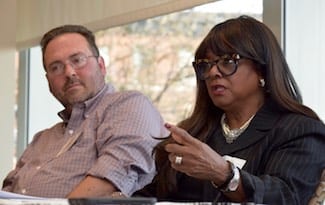
Dr. Sandra Casey Buford (right) of Synergy Resources Consulting Group answers a question during the Dec. 1 meeting of MMPA. To her left is co-presenter Bob McIntosh of the Career Center of Lowell.
In order to grow a diverse municipal workforce, everyone in the organization must recruit candidates, network to find candidates and build a talent pipeline, and promote the community.
This was the message of Dr. Sandra Casey Buford of Synergy Resources Consulting Group and Bob McIntosh of the Career Center of Lowell to members of the Massachusetts Municipal Personnel Association at the group’s meeting on Dec. 1 in Boston.
The panelists stressed the importance of a community being welcoming to women, people of color, the LGBTQ community, people with disabilities, and others underrepresented in municipal government.
“If the opportunity’s right and your organization is welcoming, I know you can find people of color to come,” Buford said. “You know why? People of color want opportunities and they want growth.”
McIntosh gave a presentation on how municipal personnel managers can best use LinkedIn and navigate its features to find candidates who match job openings. He said that it’s important for personnel managers to promote not only the community, but themselves.
A city or town’s LinkedIn profile page should include a statement that highlights the diversity of the community or support for a diverse workforce, for instance. The personnel manager’s LinkedIn profile should include a similar message.
“If you write on your profile, ‘One of the nice things about working for the town is the diversity of its employees,’ when someone is looking for a job – and trust me they’re going to go to your profile – they’re going to think, ‘Wow that’s probably a cool place to work,’ or, ‘That place is going to accept me,’” McIntosh said.
Growing the diversity of the workforce requires an active, strategic workforce plan and building a talent pipeline as part of that plan, Buford said. The plan must identify upcoming opportunities within the organization and the knowledge, skills and competencies that will be needed in the future.
“You’re going to connect that pipeline strategy to your succession planning, thinking three to five years out,” Buford said. “You’re also going to hold yourselves accountable. Measure and publish your results. If you have good news to share … then it’s really good publicity for you.”
Building a talent pipeline that matches those opportunities and skill sets requires everyone in the organization to work as a recruiter, networking and marketing the city or town’s brand at conferences, meetings and elsewhere.
Make sure to exchange business cards, email addresses or connect on LinkedIn, Buford suggested. When she gets a business card, she sends an email to that person when she gets back to her office saying it was nice to meet them, and connects with them on LinkedIn.
“Regularly follow up with those connections,” she said. “You’re building relationships with people. They’re in a pipeline so the next time the director of HR position comes up or a position in accounting, you at least have a pipeline of diverse candidates you can look at.”
McIntosh also highlighted how LinkedIn can be used to connect and communicate with potential applicants.
“You send out a job description and you wait for resumes, and you get resumes that resemble nothing like what you need,” he said, as attendees nodded in agreement. “Connect with your colleagues but also people outside – people who can help you find people.”
If a city or town is seeking an IT employee, for example, McIntosh suggested using LinkedIn’s People Search to find people you have a connection with at private companies that employ IT professionals and sending an invitation to connect, or asking for an introduction through a mutual connection.
